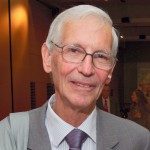Link to Pubmed [PMID] – 2504580
EMBO J. 1989 May;8(5):1433-9
In an extensive screen of a cDNA library prepared from serum-stimulated mouse NIH 3T3 cells, we identified three distinct jun-related clones. Two of them were carrying c-jun and junB sequences respectively, whereas the sequence of the third group of clones (junD) was distinct from these two and from v-jun. The amino acid sequences derived from these jun-related clones are very well conserved in five distinct regions including the putative DNA binding domain. Truncated c-Jun and JunD proteins containing the C-terminus recognize the same DNA sequences which were defined as the PEA1/AP1 binding sequence or TPA response element (TRE). Furthermore, both can trans-activate a promoter including the TRE, and this activation is further enhanced by c-fos. Contrary to c-jun and junB transcription, which are strongly stimulated by serum or TPA treatment of quiescent 3T3 cells, junD transcription is not significantly stimulated in these conditions. The tissue distribution and levels of expression of junD mRNA differ from that of c-jun and junB mRNA. These observations suggest that each of these Jun-related gene products has a distinct role in the control of gene activity and growth in the organism.
